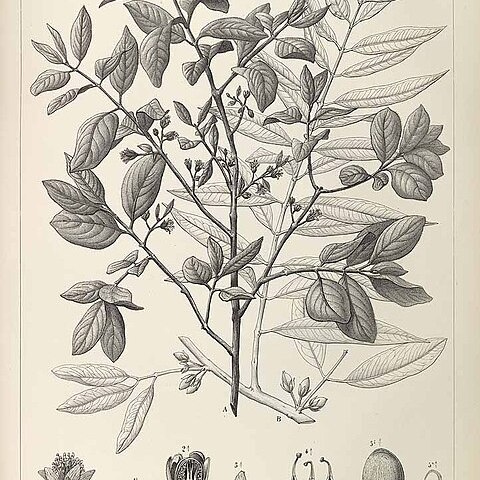Tree to 35 m tall, deciduous, glabrous, or partly pubescent; trunk spiny at base, bark grey, coarsely fissured, scaly; young shoots glabrous or pubescent, with interpetiolar scar interrupted. Leaves with petiole 5-15 mm, 3½-14 by 1-7 cm, elliptic or sometimes obovate to oblong or lanceolate or ovate, apex acute or shortly acuminate to rounded, base broadly cuneate to rounded, herbaceous to chartaceous, sometimes glaucous beneath. Inflorescence of 1-6-flowered cymules in lower axils of current shoots or, if shoot fails to develop, apparently axillary on older stems; pedicels 3-10(-15)mm. Flowers heterodistylous. Sepals 4-7 by 2-4 mm. Petals white or pink to red or (very rarely) purplish, 7-17 by 3-7 mm; nectary scale 2-4 mm, rounded, entire or sub-entire. Stamen fascicles 5-14 mm, with stamens relatively lax, 20 per fascicle; anther gland present, purple, or absent. Staminodial fascicles (if well developed) orange-red, trigonous, linguiform, attenuate to truncate, not cucullate. Ovary 2-4½ mm long; styles 2-8 mm. Capsule 10-16 by 4-6 mm, three times as long as sepals, ellipsoid, with columella ± half as long as capsule. Seeds (7-)12-17 per loculus, 6-7½ by 2-4 mm, oblanceolate.
More
A shrub or small tree. It grows 1-8 m high. The trunk has long thorns on the lower parts. The bark peels off in flakes. The leaves are simple and opposite. They are lighter green underneath. They are oblong and 4-10 cm long by 2-4 cm wide. The flowers are in groups of 5-8 in the axils of the fallen leaves. The flowers are 1.3 cm across. The fruit is a dark brown capsule that is oblong and 1-1.5 cm long. There are 6-8 seeds per section.
A sub-canopy plant in undisturbed mixed dipterocarp, keranga, (peat)-swamp, mangrove and coastal forests, at elevations up to 300 metres. Thickets, open secondary forests; at elevations below 1,000 metres in southern China.
More
In primary or old secondary forest, hill slopes, river margins or swamps, on sand or clay soils, 0-600(-1200) m. Fl. March-July (Borneo) or later (Sumatra, Banka) or earlier (Malaya).
A tropical plant. It grows in clear forests on sandy soils. It grows in dry mixed forests up to 1,000 m above sea level. In XTBG Yunnan.


